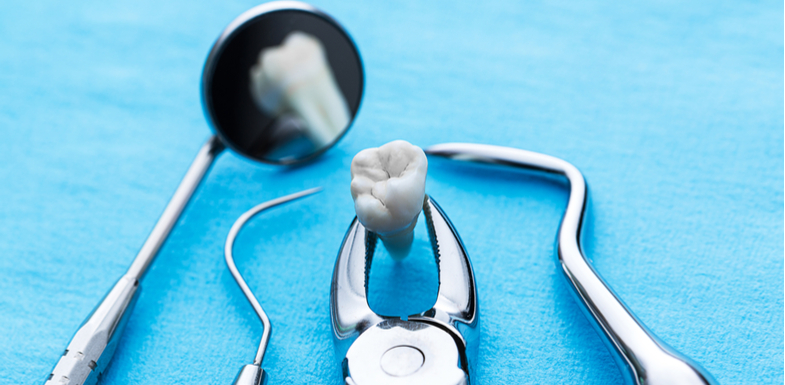When a patient’s oral health reaches the point where a tooth extraction is necessary, they usually believe that removing the tooth will solve whatever pain the tooth may be causing. While this is true for the majority of patients, in some cases, bone fragments after extraction complicate and extend the healing process.
Help! I can see bone fragments after tooth extraction
While it can be startling, bone fragments after tooth extraction are not uncommon. When a tooth is extracted, the healing process may be going along just fine, until your tongue finds a hard and possibly sharp something emerging from the healing wound.
Even if they feel like the size of a boulder in your mouth, they may not be visible until they emerge more fully. Most bone fragments after extraction are very small.
Why do bone fragments after extraction occur?
Bone fragments after extraction are more or less common depending on the type of extraction you have. In a simple extraction, your dentist uses dental pliers or other tools to gently loosen the tooth from its socket before easing it out. The tooth comes out in one piece, usually, and complications are few.
In a surgical extraction, the procedure is a bit more complicated. The offending tooth may be coming in at an angle, or it may be firmly attached to the socket. If there is little room to maneuver, or the tooth simply won’t let go, your dentist may remove the tooth in sections. Once the tooth is removed, your dentist will carefully inspect and clean the empty socket before stitching the surgical wound closed.
Trouble is, tooth pieces and root tips can be small and hidden, even after careful inspection. Somewhere between ten and 20% of patients experience a broken tooth or root tip shard that occurs after sectioning a tooth in a surgical extraction.
Fragments of dead bone tissue (sequestrum if singular, sequestra when plural) can also be left behind after extraction. These pieces may be completely missed if the damaged bone comes from the socket or jaw itself. Your dentist may extract a complete tooth and not see any chips or missing shards in the tooth itself. They may not realize that bits of dead bone have fragmented and are hidden in the extraction site. Even with bone exposed after extraction these pieces can be so small that they are missed.
Eruption sequestrum
In very rare cases, something called eruption sequestrum can occur in children with their permanent teeth coming in.
Small bone fragments perch above the erupting tooth below the gum line. When permanent teeth begin to emerge, they are preceded by small bits of bone that is not alive. These bone fragments in gums can lead parents to believe that the erupting tooth has shattered or is not intact, which is generally not the case.
Symptoms of bone fragments after tooth extraction
In the majority of patients, bone fragments after extraction will cause little to no complications past the following symptoms:
- Redness and slight swelling around the bone fragment
- Tenderness in the gum
- Whitish ulcer around the sequestrum
You may see a small, pinprick of bone, surrounded by reddish and possibly slightly swollen tissue. Only your dentist can identify it conclusively as bone fragment in the gum. Edges may be rounded or sharp. The bone itself is tan or white, and the surface is not quite smooth (but also doesn’t have obvious bumps).
While bone fragment after extraction sometimes resolves itself, there is a risk of delayed or slowed healing if the bone fragment does not emerge quickly. Additionally, if your tooth was extracted due to gum disease or other type of infection, there is a possibility that the bone fragment can damage living gum tissue on its way out. This could lead to more pain and potential infection.
Plus, seeing a piece of bone sticking out of your extraction site can be scary. It’s important to get in touch with your dentist to have them take a look. Only then can they determine if further treatment will be necessary.
How to fix bone fragments after extraction
If your bone fragment after extraction is causing pain and swelling, your dentist may need to remove it. This is a quick and painless procedure.
For bone fragments that are visible, your dentist will use a topical anesthetic and remove it with dental tweezers. They will then rinse and inspect the site carefully. You should feel near-immediate pain relief.
If a bone fragment after extraction is not visible but they suspect one is there, an X-ray can determine if a more involved surgical extraction is necessary.
It can be challenging to determine if there is a bone fragment until the bone begins to make its way towards the surface of the gums. When your dentist believes the fragment will not resolve itself, or it may cause further damage or threaten infection, surgical removal is necessary.
Numbing the gum with injected anesthetic, your dentist will make the smallest incision possible. They’ll then locate the bone fragment and gently remove it. This gives them another opportunity to clean and inspect the extraction site before stitching the site closed. If infection is present, they may prescribe antibiotics.
Whichever treatment path is taken, it is important to follow your dentist’s post-care instructions carefully for optimum healing.
AZ Dentist is your Phoenix area weekend dentist. If you are feeling the pain of bone fragments after extraction, get in touch to discuss all your treatment options.
